|
|

The Cisco 6400 SCM allows you to make and manage network connections through a set of menu options available by right clicking on an appropriate card in MapViewer. They allow you to create and configure Subscribers and Services, and to manage the subsequent connection of Subscribers to Services.
This chapter details the tasks you may need to use during day to day Service Connection Management, the name we provide to combined subscriber and service provisioning.
The tasks and windows that are required in Service Connection Management are accessed from the Chassis map in MapViewer.
Tasks and windows can also be accessed from the Objects manager, and from different objects and more than one containment tree when required. Refer to Table 6-1 for further details.
| Tasks | Launch Points | |||||||||
|---|---|---|---|---|---|---|---|---|---|---|
| NSP | NRP | NRP ATM Port | Line Card | Line Card ATM Port | DSLAM | Service Instance | Subscriber | Subscriber QoS | Connection | |
Configure Service Profiles | Yes | Yes | Yes | Yes | Yes | No | Yes | No | No | No |
Configure QoS Profiles | Yes | No | Yes | Yes | Yes | Yes | No | Yes | Yes | No |
Configure Services | Yes | Yes | Yes | Yes | Yes | No | Yes | No | No | Yes |
Configure Subscribers | Yes | No | Yes | Yes | Yes | Yes | No | Yes | Yes | Yes |
Configure Subscriber QoS | Yes | No | Yes | Yes | Yes | Yes | No | Yes | Yes | No |
Connect Subscribers | Yes | Yes | Yes | Yes | Yes | Yes | Yes | Yes | No | No |
Disconnect Subscribers | Yes | Yes | Yes | Yes | Yes | Yes | Yes | Yes | No | Yes |
Deploy DSLAM | No | No | Yes | Yes | Yes | No | No | No | No | No |
Deploy Subscriber and QoS | No | No | Yes | Yes | Yes | Yes | No | No | No | No |
Deploy Subscriber QoS | No | No | Yes | Yes | Yes | Yes | No | Yes | No | No |
Deploy Service Instance | No | No | Yes | Yes | Yes | No | No | No | No | No |
Many service providers and telecommunications carriers now offer tiered service levels to their customers and/or subscribers. These service levels are generally defined by the marketing policy of the carrier or service provider.
Configuration of the 6400 SCM service and subscriber provisioning involves the definition of a large number of parameters that are common across these policies.
The 6400 SCM utilizes the concept of a configuration profile to simplify the definition of both service parameters and subscriber QoS parameters.
A configuration profile is therefore a set of configuration parameters (or attributes) that can be set up in advance before the actual configuration operation. These profiles are saved in the CEMF database. The 6400 SCM profiles therefore speeds up both subscriber provisioning and service provisioning.
Without the use of profiles, you would have to enter a repetitive definition of the same (or similar) information for service or subscriber provisioning operations.
For example, you may wish to define "bronze" (low data rate, inexpensive), "silver" and "gold" (high data rate, expensive) profiles for subscriber QoS. This provides a simple method for use during the subscriber provisioning operation and saves retyping all of the QoS parameters individually for each new subscriber.
A typical work flow is described in this section, you can use this example as a tutorial.
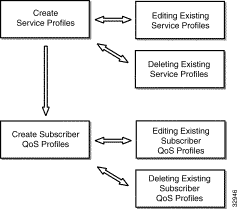
This section describes how to use the 6400 SCM profile definition windows. The precise parameter values that you select for each service or subscriber QoS are dependent upon your network topology and market service offerings.
Refer to the "Service Profile Configuration Window" section for further information on the meaning of each service topology and service parameter.
This section describes the use of service profiles to simplify 6400 SCM service provisioning. There are two methods for accessing the various Cisco 6400 SCM Service Profile windows:
1. Select the Cisco 6400 UAC, Profiles, Configure Service Profiles option from an NSP object using the MapViewer application (for service types PPP-IP, PPP-L2TP, Bridged-Bridged, and Bridged-Routed).
OR
2. Select the Cisco 6400 UAC, Profiles, Configure <Service> Profiles option from an NSP object using the MapViewer application (for service types RBE, PTA-MD, and RFC1483 Routing. Where <Service> is service type RBE, PTA-MD, or RFC1483 Routing.
Service profiles are used to define configuration parameters for the uplink from the 6400 UAC to the service provider.
You can set up profiles and apply them or, alternatively, you can configure a service manually. The services available on the 6400 UAC have a number of parameters to configure. It is worth setting up a number of service profiles with at least some of the values complete (that can be applied later) to save time.
Step 1 Select the Cisco 6400 UAC, Profiles, Configure Service Profiles option from any card type (that is NSP, NRP or Line Card). Profiles are "globally" obtained within the 6400 SCM.
The Service Profile Configuration window appears with the General tab displayed:
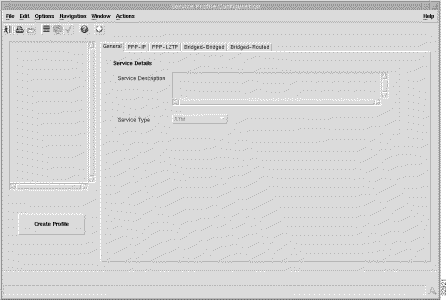
Step 2 Select Create Profile.
A Prompt window appears.

Step 3 Enter a name for the profile in the Enter profile name data entry box. Premium Profile was entered in the example shown in Figure 6-3.
The Service Profile Configuration window reappears with the new profile name displayed in the left-hand-side of the window.
Step 4 Select the General tab (shown in Figure 6-2) if it is not already selected.
Step 5 Enter a description into the Service Description data entry box in the Service Details frame.
Step 6 Select a Service Type from the drop down list. This Service Type is a range of options you can use to configure the uplink from the 6400 UAC to the upstream service provider.
As an example, the PPP-IP Service Type is selected.

Step 7 Edit the parameters into the Virtual Template Parameters frame, as required. The Virtual Template Parameters describe the PPP characteristics used to terminate the incoming PPP traffic. You should set the parameters appropriate to your network topology and services to be offered.
Step 8 Edit the parameters in the IP Address Pool frame, as required. The IP Address Pool set the range of IP addresses available to a subscriber.
Step 9 Select the Encapsulation Type in the VC Class Parameters frame. The VC Class Parameters define the characteristics of the incoming ATM traffic.
Step 10 Select Save from the File menu to save the parameters you have selected for your service profile.
Step 11 Select Close from the File menu to close the window.
To edit an existing service profile, proceed as follows:
Step 1 Select the Cisco 6400 UAC, Profiles, Configure Service Profiles option from an NRP Card on the MapViewer.
The Service Profile Configuration window appears with the General tab displayed. Existing service profiles are displayed at the left-hand-side of the window.

Step 2 Select the profile you wish to edit from the list of profiles displayed. The Premium Profile is selected in the example shown in Figure 6-5.
Step 3 Select the General tab (shown in Figure 6-2) if it is not already selected.
Step 4 Edit the parameters in the General tab as required.
Step 5 Select the appropriate service tab for the Service Type selected.
Step 6 Edit the parameters in the appropriate service tab as required.
Step 7 Select Save from the File menu to save the configuration.
Step 8 Select Close from the File menu to close the window and save the changes made.
To delete an existing service profile, proceed as follows:
To edit an existing subscriber QoS profile, proceed as follows:
Step 1 Select the Cisco 6400 UAC, Profiles, Configure Service Profiles option from an NRP Card.
The Service Profile Configuration window appears with the General tab displayed. Existing service profiles are displayed at the left-hand-side of the window.
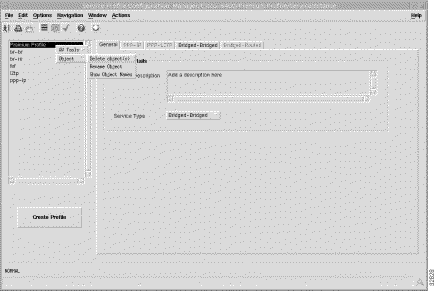
Step 2 Select the existing service profile that you wish to delete. In the example (shown in Figure 6-21) the Premium Profile is selected.
Step 3 Right click and select Delete object(s) option.
The Deletion Summary Screen appears.

Step 4 Check the details in the Deletion Summary Screen.
Step 5 Select Finish to delete the selected profile. The delete operation is initiated.
Step 6 Select Dismiss to close the Deletion Summary Screen.
Service profiles are used to define configuration parameters for the uplink from the 6400 UAC to the service provider.
You can set up profiles and apply them or, alternatively, you can configure a service manually. The services available on the 6400 UAC have a number of parameters to configure. It is worth setting up a number of service profiles with at least some of the values complete (that can be applied later) to save time.
Step 1 Select the Cisco 6400 UAC, Profiles, Configure PTA-MD Profiles option from any card type (that is NSP, NRP or Line Card) using the MapViewer application.
The PTA-MD Service Profile Window (PTA-MD Tab) appears. The PTA-MD Service Profile window has two tabbed sections: PTA-MD and Local Service Profiles.
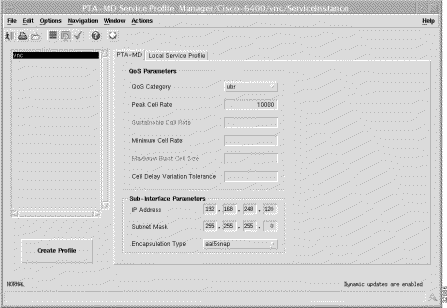
Step 2 Select Create Profile.
A Prompt window appears.

Step 3 Enter a name for the profile in the Enter profile name data entry box. Premium Profile was entered in the example shown in Figure 6-9.
The PTA-MD Service Profile window reappears with the new profile name displayed in the left-hand-side of the window.
Step 4 Select the PTA-MD tab (shown in Figure 6-8) if it is not already selected.
Step 5 Edit the parameters in the QoS Parameters and Sub-Interface Parameters frames as required.
Step 6 Select the Local Service Profile tab.
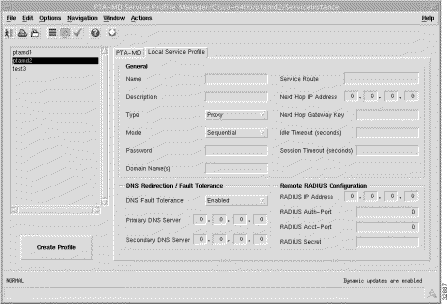
Step 7 Enter parameters into the General, DNS Redirection/Fault Tolerance, and the Remote RADIUS Configuration frames.
Step 8 Select Save from the File menu to save the parameters you have selected for your service profile.
Step 9 Select Close from the File menu to close the window.
Step 1 Select the Cisco 6400 UAC, Profiles, Configure PTA-MD Profiles option from any card type (that is NSP, NRP or Line Card).
The PTA-MD Service Profile Window (PTA-MD Tab) appears. The PTA-MD Service Profile window (shown in Figure 6-8) has two tabbed sections: PTA-MD and Local Service Profiles.
Step 2 Select the profile you wish to edit from the list of profiles displayed on the left-hand-side of the window.
Step 3 Edit the parameters in the PTA-MD and Local Service Profiles tabs as required.
Step 4 Select Save from the File menu to save the configuration.
Step 5 Select Close from the File menu to close the window and save the changes made.
Step 1 Select the Cisco 6400 UAC, Profiles, Configure PTA-MD Profiles option from any card type (that is NSP, NRP or Line Card).
The PTA-MD Service Profile Window (PTA-MD Tab) appears. The PTA-MD Service Profile window (shown in Figure 6-8) has two tabbed sections: PTA-MD and Local Service Profiles.
Step 2 Select the profile you wish to edit from the list of profiles displayed on the left-hand-side of the window.
Step 3 Right click and select Delete object(s) option.
The Deletion Summary Screen appears.

Step 4 Check the details in the Deletion Summary Screen.
Step 5 Select Finish to delete the selected profile. The delete operation is initiated.
Step 6 Select Dismiss to close the Deletion Summary Screen.
Service profiles are used to define configuration parameters for the uplink from the 6400 UAC to the service provider.
You can set up profiles and apply them or, alternatively, you can configure a service manually. The services available on the 6400 UAC have a number of parameters to configure. It is worth setting up a number of service profiles with at least some of the values complete (that can be applied later) to save time.
Step 1 Select the Cisco 6400 UAC, Profiles, Configure RBE Profiles option from any card type (that is NSP, NRP or Line Card) using the MapViewer application.

Step 2 Select Create Profile.
A Prompt window appears.

Step 3 Enter a name for the profile in the Enter profile name data entry box. Premium Profile was entered in the example shown in Figure 6-13.
The RBE Service Profile window reappears with the new profile name displayed at the left-hand-side of the window.
Step 4 Edit the parameters in the QoS Parameters and Sub-Interface Parameters frames as required.
Step 5 Select Save from the File menu to save the parameters you have selected for your service profile.
Step 6 Select Close from the File menu to close the window.
Step 1 Select the Cisco 6400 UAC, Profiles, Configure RBE Profiles option from any card type (that is NSP, NRP or Line Card).
The RBE Service Profile Window appears.
Step 2 Select the profile you wish to edit from the list of profiles displayed on the left-hand-side of the window.
Step 3 Edit the parameters in the QoS Parameters and Sub-Interface Parameters frames as required.
Step 4 Select Save from the File menu to save the configuration.
Step 5 Select Close from the File menu to close the window and save the changes made.
Step 1 Select the Cisco 6400 UAC, Profiles, Configure RBE Profiles option from any card type (that is NSP, NRP or Line Card).
The RBE Service Profile Window (RBE Tab) appears.
Step 2 Select the profile you wish to edit from the list of profiles displayed on the left-hand-side of the window.
Step 3 Right click and select Delete object(s) option.
The Deletion Summary Screen appears.

Step 4 Check the details in the Deletion Summary Screen.
Step 5 Select Finish to delete the selected profile. The delete operation is initiated.
Step 6 Select Dismiss to close the Deletion Summary Screen.
Service profiles are used to define configuration parameters for the uplink from the 6400 UAC to the service provider.
You can set up profiles and apply them or, alternatively, you can configure a service manually. The services available on the 6400 UAC have a number of parameters to configure. It is worth setting up a number of service profiles with at least some of the values complete (that can be applied later) to save time.
Step 1 Select the Cisco 6400 UAC, Profiles, Configure RFC1483 Profiles option from any card type (that is NSP, NRP or Line Card) using the MapViewer application.

Step 2 Select Create Profile.
A Prompt window appears.

Step 3 Enter a name for the profile in the Enter profile name data entry box. Premium Profile was entered in the example shown in Figure 6-16.
The RFC1483 Service Profile window reappears with the new profile name displayed in the left-hand-side of the window.
Step 4 Edit the parameters in the QoS Parameters and Sub-Interface Parameters frames as required.
Step 5 Select Save from the File menu to save the parameters you have selected for your service profile.
Step 6 Select Close from the File menu to close the window.
Step 1 Select the Cisco 6400 UAC, Profiles, Configure RFC1483 Profiles option from any card type (that is NSP, NRP or Line Card).
The RBE Service Profile Window (shown in Figure 6-15) appears.
Step 2 Select the profile you wish to edit from the list of profiles displayed on the left-hand-side of the window.
Step 3 Edit the parameters in the QoS Parameters and Sub-Interface Parameters frames as required.
Step 4 Select Save from the File menu to save the configuration.
Step 5 Select Close from the File menu to close the window and save the changes made.
Step 1 Select the Cisco 6400 UAC, Profiles, Configure RFC1483 Profiles option from any card type (that is NSP, NRP or Line Card).
The RFC1483 Service Profile Window appears.
Step 2 Select the profile you wish to edit from the list of profiles displayed on the left-hand-side of the window.
Step 3 Right click and select Delete object(s) option.
The Deletion Summary Screen appears.

Step 4 Check the details in the Deletion Summary Screen.
Step 5 Select Finish to delete the selected profile. The delete operation is initiated.
Step 6 Select Dismiss to close the Deletion Summary Screen.
A QoS profile is a method of defining a set of QoS parameters in advance that can be applied to a number of subscriber QoS objects without having to enter the same information each time.
The subscriber QoS profile applies to the subscriber traffic incoming to the Cisco 6400 UAC, for example, from the DSLAM to the 6400 UAC.
To create a subscriber QoS profile, proceed as follows:
Step 1 Start MapViewer and select the Chassis map.
Step 2 Select the Cisco 6400 UAC, Profiles, Configure Subscriber QoS Profiles option from a Line Card.
The Subscriber QoS Profiles window appears.

Step 3 Select the Create Profile button.
A Prompt window appears.

Step 4 Enter a name for the QoS profile in the Enter profile name data entry box.
In the example (shown in Figure 6-19) Gold-QoS-Profile is entered as an example. Typical names are Gold, Silver or Bronze profile.
Step 5 Click Ok to accept the profile name. The new profile name appears in the profile list (displayed above the Create Profile button) in the Subscriber QoS Profiles window.
Step 6 Enter a description in the QoS Description entry box. This is an optional parameter that allows you to add additional relevant information.
Step 7 Enter/select values in the QoS Parameters frame. Select ubr as the QoS Category, enter 900 for the Peak Cell Rate and leave the remaining fields blank.
The values entered into the QoS Parameters frame are normally defined in the Service Providers policy.
Step 8 Select the Save option from the File menu to save to save the parameters you have selected for your QoS profile.
Step 9 Select the Close option from the File menu to close the Subscriber QoS Profiles window.
To edit an existing subscriber QoS profile, proceed as follows:
Step 1 Start MapViewer and select the Chassis map.
Step 2 Select the Cisco 6400 UAC, Profiles, Configure Subscriber QoS Profiles option from a Line Card.
The Subscriber QoS Profiles window appears.
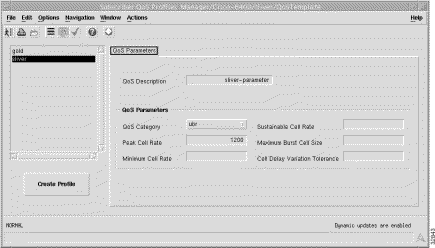
Step 3 Select the existing QoS profile that you wish to edit. In the example (shown in Figure 6-20) the silver profile is selected.
Step 4 Edit the description in the QoS Description entry box (if required).
Step 5 Enter/select values in the QoS Parameters frame as required.
Step 6 Select the Save option from the File menu.
Step 7 Select the Close option from the File menu to close the Subscriber QoS Profiles window.
To delete an existing subscriber QoS profile, proceed as follows:
Step 1 Start MapViewer and select the Chassis map.
Step 2 Select the Cisco 6400 UAC, Profiles, Configure Subscriber QoS Profiles option from a Line Card.
The Subscriber QoS Profiles window appears.
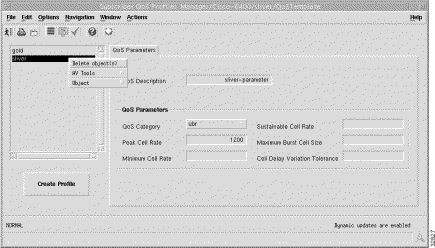
Step 3 Select the existing QoS profile that you wish to delete. In the example (shown in Figure 6-21) the silver profile is selected.
Step 4 Right click and select Delete object(s) option.
The Deletion Summary Screen appears.

Step 5 Check the details in the Deletion Summary Screen.
Step 6 Select Finish to delete the selected QoS profile.
Step 7 Select Dismiss to close the Deletion Summary Screen.
One of the most important aspect of the Cisco 6400 SCM application is Service Connection Management. The Cisco 6400 UAC contains multiple network elements, an ATM switch, multiple router cards (NRPs), and multiple line cards. Services are deployed across these network elements, a multistage process involving both SNMP and Cisco IOS management commands. The Cisco 6400 SCM application enables point-and-click connection of end subscribers to 6400-based services with all of the underlying IOS and SNMP operation hidden.
This section describes service subscriber management using a number of work flows to describe how to connect services to subscribers.
The 6400 SCM software is designed to help simplify Cisco 6400 UAC service configuration.
A typical work flow is described in this section, you can use this example as a tutorial.

A service instance is an object that holds all the information related to that service. Service Instances are deployed from different launch points (depending on the type of service instance you wish to deploy).
Step 1 Select the Deploy, Cisco 6400, Service Instance option from the egress ATM line card object using the MapViewer application for the pure ATM switching service.
OR
Select the Deploy, Cisco 6400, Service Instance option from an NSP object using the MapViewer application for all other NRP based service types (that is, PPP-IP, PPP-L2TP, Bridged-Bridged, Bridged-Routed, PTA-MD, RBE, and RFC1483 routing).
The Deployment Selector Screen appears.
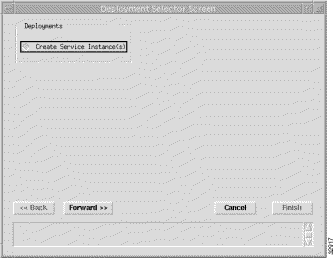
Step 2 Select the Create Service Instance(s) option (if not already selected).
Step 3 Select Forward.
The Deployment Details Screen appears.
Step 4 Enter the Number of Service Instances to create. Enter "1" for this example.
Step 5 Select Forward.
Step 6 Enter a Service Instance Name. Enter Premium as an example.
Step 7 Select Forward.
Step 8 Select the NRP ATM Port the Service Instance is to reside on in the serviceInstanceContainment window.
Step 9 Select Apply.
Step 10 Select the NRP ATM Port that the Service Instance is to reside on in the mgmtContainment window.
Step 11 Select Apply.
Step 12 Repeat steps 6 to 11 for the Number of Service Instances entered in step 4.
Step 13 Click Forward. The Deployment Summary screen appears.
The Deployment Summary details appear in the Deployment Summary Screen.
Step 14 Click Finish (if the Deployment Summary information is correct) to commit the deployment and create the Service Instance.
Step 15 Click Dismiss to close the Deployment Summary Screen.
Step 1 Select the Cisco 6400 UAC, Service, Configure Services option from an NRP Card (for all services except pure ATM switching). You cannot apply a profile to the pure ATM switching service.
The Service Instance Configuration window appears.

Step 2 Select the appropriate NSP, ATM Port and Service Instance from the appropriate list displayed at the left-hand-side of the window.
Step 3 Select Apply Profile from the Edit menu. The profile parameters are copied to the appropriate service instance parameters.
Step 4 Select the appropriate profile from the list of profiles displayed.
Step 5 Add or modify parameter options, if required.
Step 6 Select Save to save the Service Instance.
Step 7 Commission the Service Instance after a Service Profile has been applied. To configure a service instance, you can either apply a pre-defined service profile or directly edit the service parameters.
Step 8 Select Close from the File menu to close the Service Instance Configuration window.
Step 9 Proceed to the "Commissioning a Service Instance" section. You should select the ATM port upon which you previously created (that is, deployed) a service instance.
Service Instances are deployed from different launch points (depending on the type of service instance you wish to deploy).
Step 1 Select the Deploy, Cisco 6400, Configure Service option from the egress ATM line card object using the MapViewer application for the pure ATM switching service.
OR
Select the Deploy, Cisco 6400, Configure Service option from an NSP object using the MapViewer application for all other NRP based service types (that is, PPP-IP, PPP-L2TP, Bridged-Bridged, and Bridged-Routed).
The Service Instance Configuration window appears.

Step 2 Select the appropriate NSP, ATM Port and Service Instance from the appropriate list displayed at the left-hand-side of the window.
Step 3 Select the General tab (shown in Figure 6-26) if it is not already selected.
Step 4 Enter a description into the Service Description data entry box in the Service Details frame.
Step 5 Select whether to Allow or Prevent oversubscription.
The Oversubscription option is set to Allow by default and an unlimited number of subscribers can be connected to the service. Selecting to Prevent Oversubscription ensures that the SCM limits the number of subscribers connected such that the sum of the subscriber's peak cell rates never exceeds the peak cell rate reserved for the service on the uplink. Oversubscription functionality is not applicable to the PPP-IP and ATM services.
Step 6 Select a Service Type from the drop down list. This Service Type is a range of options you can use to configure the uplink from the 6400 UAC to the upstream service provider.
As an example, the ATM service type is selected.
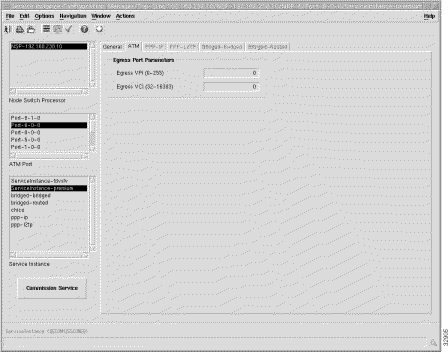
Step 7 Enter/select values for each of the parameters displayed in the selected service tab, as appropriate.
Step 8 Select Save from the File menu to save the configuration.
Step 9 Select Close from the File menu to close the window.
This is the first stage at which you actually "roll" the selected service configuration onto the 6400 UAC hardware.
The ATM service is set up by configuring the parameters displayed in the Service Instance Configuration window, shown in Figure 6-28.
To configure the pure ATM switching service, proceed as follows:
Step 1 Select the line card (from MapViewer) upon which you wish to deploy the ATM service instance.
Step 2 Select the Cisco 6400 UAC, Services, Configure Services option.
The Service Instance Configuration window (General tab) appears.
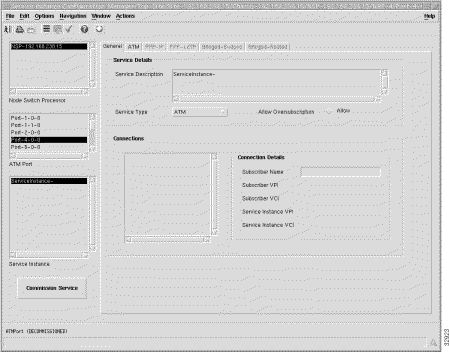
Step 3 Enter a Service Description in the Service Details frame, if required.
Step 4 Select a Service Type (ATM option) in the Service Details frame.
When a Service Type is selected the service tabs that do not relate to this service are greyed out and cannot be selected. For example, when the ATM service is selected the PPP-IP, PPP-L2TP, Bridged-Bridged and Bridged-Routed tabs are greyed out.
Step 5 Select the ATM tab. The Service Instance Configuration Window (ATM Tab) is displayed.

Step 6 Enter values into the Egress Port Parameters frame, as required.
Refer to the "Service Instance Configuration Window" section for details on each of the parameters displayed on the ATM tab.
Step 7 Select Commission Service to roll the service onto the 6400 UAC.
A pop up window appears for you to confirm that you wish to commission the selected service.

Step 8 Select Yes to commission the service (or No to return to the Service Instance Configuration window).
The Action Report window appears.
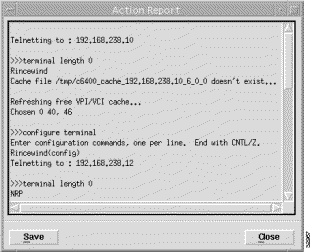
The Action Report window details the IOS commands executed when the service is commissioned. Invalid IOS commands result in a failure to commission the service.
Step 9 Check the details in the Action Report window to ensure that the service was commissioned successfully.
Step 10 Select Save to save the Action Report, if required.
Step 11 Select Close to close the Action Report window and return to the Service Instance Configuration window.
Step 12 Select Close from the File menu to close the Service Instance Configuration window.
The PPP-IP service is set up by configuring the various parameters displayed in the Service Instance Configuration window (PPP-IP tab), shown in Figure 6-33.
To commission the PPP-IP service, proceed as follows:
Step 1 Select the NRP (from MapViewer) upon which you wish to deploy the PPP-IP service instance.
Step 2 Select the Cisco 6400 UAC, Services, Configure Services option at an NRP. The Service Instance Configuration Window (General Tab) appears.

Step 3 Select the Apply Profile option from the Edit menu, if applicable. Select the profile you wish to apply from the list of profiles displayed. When a profile is applied the parameters are copied and saved automatically.
Refer to the "Creating Service Profiles (for PPP-IP, PPP-L2TP, Bridged-Bridged, and Bridged-Routed Services)" section for details of how to create service profiles.
Refer to the "Service Instance Configuration Window" section for details on each of the parameters displayed on the PPP-IP tab.
Step 4 Enter a Service Description in the Service Details frame, if required.
Step 5 Select the PPP-IP option as the Service Type in the Service Details frame.
When a Service Type is selected the service tabs that do not relate to this service are greyed out and cannot be selected. For example, when the PPP-IP service is selected the ATM, PPP-L2TP, Bridged-Bridged and Bridged-Routed tabs are greyed out.
Step 6 Select the PPP-IP tab.

Step 7 Enter values into the Virtual Template Parameters, IP Address Pool, and VC Class Parameters frames, as required.
Refer to the "Creating Service Profiles (for PPP-IP, PPP-L2TP, Bridged-Bridged, and Bridged-Routed Services)" section for details of how to create service profiles.
Step 8 Refer to the "Service Instance Configuration Window" section for details on each of the parameters displayed on the PPP-IP tab.
Step 9 Select Commission Service to roll the service onto the 6400 UAC.
A pop up window appears for you to confirm that you wish to commission the selected service.

Step 10 Select Yes to commission the service (or No to return to the Service Instance Configuration window).
The Action Report window appears.

The Action Report window details the IOS commands executed when the service is commissioned. Invalid IOS commands result in a failure to commission the service.
Step 11 Check the details in the Action Report window to ensure that the service was commissioned successfully.
Step 12 Select Save to save the Action Report, if required.
Step 13 Select Close to close the Action Report window and return to the Service Instance Configuration window.
Step 14 Select Close from the File menu to close the Service Instance Configuration window.
For the PPP-IP service to pass traffic to a designated trunk port, Cisco IOS must be used (to route traffic via layer 3 to a destination network). One way of doing this is to create a PVC on the NRP to support the routing of traffic to the trunk port and then create the required entries in the IP Routing Table.
Execute (on the selected NRP) the following IOS commands to configure a PPP-IP service to pass traffic to a designated trunk port:
NRP(config)#interface atm0/0/0.<Sub-Interface Number> point-to-point
NRP(config-if)#ip address <IP Address> <Subnet Mask>
NRP(config-if)#pvc <NRP-Interface-vpi>/<NRP-Interface-vci>
NRP(config-if-vc)#class <vc-class-name>
NRP(config-if-vc)#protocol ip <Dest IP Address> no broadcast
where,
Now create the required entries in the IP Routing Table:
NRP(config)#ip route <Dest IP Address> 255.255.255.255 atm0/0/0.<Sub-Interface Number>
where,
The PPP-L2TP service is set up by configuring the various parameters displayed in the Service Instance Configuration window (PPP-L2TP tab), shown in Figure 6-37.
To commission the PPP-L2TP service, proceed as follows:
Step 1 Select the NRP (from MapViewer) upon which you wish to deploy the service instance.
Step 2 Select the Cisco 6400 UAC, Services, Configure Services option at an NRP. The Service Instance Configuration Window (General Tab) appears.

Step 3 Select the Apply Profile option from the Edit menu, if applicable. Select the profile you wish to apply from the list of profiles displayed. When a profile is applied the parameters are copied and saved automatically.
Refer to the "Creating Service Profiles (for PPP-IP, PPP-L2TP, Bridged-Bridged, and Bridged-Routed Services)" section for details of how to create service profiles.
Refer to the "Service Instance Configuration Window" section for details on each of the parameters displayed on the PPP-L2TP tab.
Step 4 Enter a Service Description in the Service Details frame, if required.
Step 5 Select the PPP-L2TP option as the Service Type in the Service Details frame.
When a Service Type is selected the service tabs that do not relate to this service are greyed out and cannot be selected. For example, when the PPP-L2TP service is selected the ATM, PPP-IP, Bridged-Bridged and Bridged-Routed tabs are greyed out.
Step 6 Select the PPP-L2TP tab.

Step 7 Enter values into the Egress Port Parameters, Egress Port QoS Parameters, Sub-Interface Parameters, NSP/NRP Interface PVC Parameters, Tunnel Parameters, VC Class Parameters, and Virtual Template Parameters frames, as required.
Refer to the "Creating Service Profiles (for PPP-IP, PPP-L2TP, Bridged-Bridged, and Bridged-Routed Services)" section for details of how to create service profiles.
Refer to the "Service Instance Configuration Window" section for details on each of the parameters displayed on the PPP-IP tab.
Step 8 Select Commission Service to roll the service onto the 6400 UAC.
A pop up window appears for you to confirm that you wish to commission the selected service.

Step 9 Select Yes to commission the service (or No to return to the Service Instance Configuration window).
The Action Report window appears.

The Action Report window details the IOS commands executed when the service is commissioned. Invalid IOS commands result in a failure to commission the service.
Step 10 Check the details in the Action Report window to ensure that the service was commissioned successfully.
Step 11 Select Save to save the Action Report, if required.
Step 12 Select Close to close the Action Report window and return to the Service Instance Configuration window.
Step 13 Select Close from the File menu to close the Service Instance Configuration window.
The Bridged-Bridged service is set up by configuring the various parameters displayed in the Service Instance Configuration window (Bridged-Bridged tab), shown in Figure 6-41.
To commission the Bridged-Bridged service, proceed as follows:
Step 1 Select the NRP (from MapViewer) upon which you wish to deploy the service instance.
Step 2 Select the Cisco 6400 UAC, Services, Configure Services option at an NRP. The Service Instance Configuration Window (General Tab) appears.

Step 3 Select the Apply Profile option from the Edit menu, if applicable. Select the profile you wish to apply from the list of profiles displayed. When a profile is applied the parameters are copied and saved automatically.
Refer to the "Creating Service Profiles (for PPP-IP, PPP-L2TP, Bridged-Bridged, and Bridged-Routed Services)" section for details of how to create service profiles.
Refer to the "Service Instance Configuration Window" section for details on each of the parameters displayed on the Bridged-Bridged tab.
Step 4 Enter a Service Description in the Service Details frame, if required.
Step 5 Select the Bridged-Bridged option as the Service Type in the Service Details frame.
When a Service Type is selected the service tabs that do not relate to this service are greyed out and cannot be selected. For example, when the Bridged-Bridged service is selected the ATM, PPP-IP, PPP-L2TP, Bridged-Bridged and Bridged-Routed tabs are greyed out.
Step 6 Select the Bridged-Bridged tab.

Step 7 Enter values into the Egress Port Parameters, Egress Port QoS Parameters, Bridge Parameters, NSP/NRP Interface PVC Parameters, Subscriber Policy, and VC Class Parameters frames, as required.
Refer to the "Creating Service Profiles (for PPP-IP, PPP-L2TP, Bridged-Bridged, and Bridged-Routed Services)" section for details of how to create service profiles.
Refer to the "Service Instance Configuration Window" section for details on each of the parameters displayed on the Bridged-Bridged tab.
Step 8 Select Commission Service to roll the service onto the 6400 UAC.
A pop up window appears for you to confirm that you wish to commission the selected service.

Step 9 Select Yes to commission the service (or No to return to the Service Instance Configuration window).
The Action Report window appears.

The Action Report window details the IOS commands executed when the service is commissioned. Invalid IOS commands result in a failure to commission the service.
Step 10 Check the details in the Action Report window to ensure that the service was commissioned successfully.
Step 11 Select Save to save the Action Report, if required.
Step 12 Select Close to close the Action Report window and return to the Service Instance Configuration window.
Step 13 Select Close from the File menu to close the Service Instance Configuration window.
The Bridged-Routed service is set up by configuring the various parameters displayed in the Service Instance Configuration window (Bridged-Routed tab), shown in Figure 6-45.
To commission the Bridged-Routed service, proceed as follows:
Step 1 Select the NRP (from MapViewer) upon which you wish to deploy the service instance.
Step 2 Select the Cisco 6400 UAC, Services, Configure Services option at an NRP. The Service Instance Configuration Window (General Tab) appears.

Step 3 Select the Apply Profile option from the Edit menu, if applicable. Select the profile you wish to apply from the list of profiles displayed. When a profile is applied the parameters are copied and saved automatically.
Refer to the "Creating Service Profiles (for PPP-IP, PPP-L2TP, Bridged-Bridged, and Bridged-Routed Services)" section for details of how to create service profiles.
Refer to the "Service Instance Configuration Window" section for details on each of the parameters displayed on the Bridged-Routed tab.
Step 4 Enter a Service Description in the Service Details frame, if required.
Step 5 Select the Bridged-Routed option as the Service Type in the Service Details frame.
When a Service Type is selected the service tabs that do not relate to this service are greyed out and cannot be selected. For example, when the Bridged-Routed service is selected the ATM, PPP-IP, PPP-L2TP, Bridged-Bridged and Bridged-Bridged tabs are greyed out.
Step 6 Select the Bridged-Routed tab.
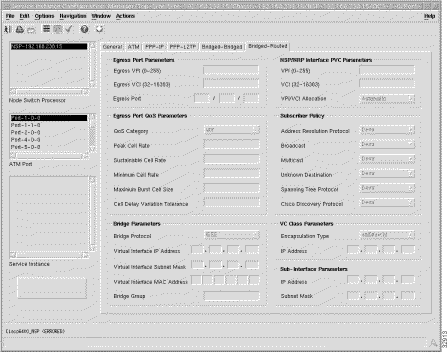
Step 7 Enter values into the Egress Port Parameters, Egress Port QoS Parameters, Bridge Parameters, NSP/NRP Interface PVC Parameters, Subscriber Policy, VC Class Parameters, and Sub-Interface Parameters frames, as required.
Refer to the "Creating Service Profiles (for PPP-IP, PPP-L2TP, Bridged-Bridged, and Bridged-Routed Services)" section for details of how to create service profiles.
Refer to the "Service Instance Configuration Window" section for details on each of the parameters displayed on the Bridged-Routed tab.
Step 8 Select Commission Service to roll the service onto the 6400 UAC.
A pop up window appears for you to confirm that you wish to commission the selected service.

Step 9 Select Yes to commission the service (or No to return to the Service Instance Configuration window).
The Action Report window appears.

The Action Report window details the IOS commands executed when the service is commissioned. Invalid IOS commands result in a failure to commission the service.
Step 10 Check the details in the Action Report window to ensure that the service was commissioned successfully.
Step 11 Select Save to save the Action Report, if required.
Step 12 Select Close to close the Action Report window and return to the Service Instance Configuration window.
Select Close from the File menu to close the Service Instance Configuration window.
The PTA-MD service is set up by configuring the parameters displayed in the PTA-MD Service Configuration window (PTA-MD tab), shown in Figure 6-48.
To commission the PTA-MD service, proceed as follows:
Step 1 Select the NRP (from MapViewer) upon which you wish to deploy the PTA-MD service instance.
Step 2 Select the Cisco 6400 UAC, Services, Configure PTA-MD Service option at an NRP to display the PTA-MD Service Instance Configuration window.
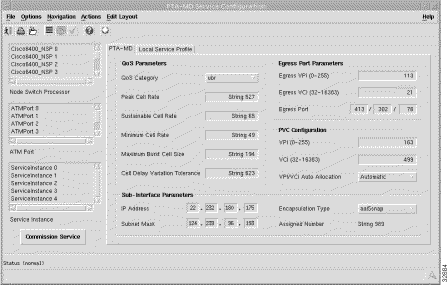
Step 3 Select the Apply Profile option from the Edit menu, if applicable. Select the profile you wish to apply from the list of profiles displayed. When a profile is applied the parameters are copied and saved automatically.
Refer to the "Creating Service Profiles for a PTA-MD Service" section for details of how to create service profiles.
Step 4 Enter values into the QoS Parameters, Sub-Interface Parameters, Egress Port Parameters, and PVC Configuration frames, as required.
Refer to the "PTA-MD Service Configuration Window" section for details on each of the parameters displayed on the PTA-MD tab.
Step 5 Select the Local Service Profile tab.

Step 6 Enter values into the General, DNS Redirection/Fault Tolerance, and Remote RADIUS Configuration frames, as required.
The Remote RADIUS Configuration parameters are only available when Proxy is selected as the service Type.
Refer to the "Local Service Profile Tab" section for details on each of the parameters displayed on the Local Service Profile tab.
Step 7 Select Commission Service to roll the service onto the 6400 UAC.
A pop up window appears for you to confirm that you wish to commission the selected service.

Step 8 Select Yes to commission the service (or No to return to the Service Instance Configuration window).
The Action Report window appears.

The Action Report window details the IOS commands executed when the service is commissioned. Invalid IOS commands result in a failure to commission the service.
Step 9 Check the details in the Action Report window to ensure that the service was commissioned successfully.
Step 10 Select Save to save the Action Report, if required.
Step 11 Select Close to close the Action Report window and return to the Service Instance Configuration window.
Step 12 Select Close from the File menu to close the Service Instance Configuration window.
The RBE service is set up by configuring the parameters displayed in the RBE Service Configuration window (Route Bridge Encapsulation tab), shown in Figure 6-52.
To commission the RBE Service Configuration window (Route Bridge Encapsulation tab), proceed as follows:
Step 1 Select the NRP (from MapViewer) upon which you wish to deploy the RBE service instance.
Step 2 Select the Cisco 6400 UAC, Services, Configure RBE Service option at an NRP to display the RBE Service Configuration window.
The RBE Service Configuration window (Route Bridge Encapsulation Tab) appears.

Step 3 Select the Apply Profile option from the Edit menu, if applicable. Select the profile you wish to apply from the list of profiles displayed. When a profile is applied the parameters are copied and saved automatically.
Refer to the "Creating Service Profiles for an Route Bridge Encapsulation (RBE) Service" section for details of how to create service profiles.
Step 4 Enter values into the QoS Parameters, Sub Interface Parameters, Egress Port Parameters, PVC Configuration, and Next Hop frames, as required.
Refer to the "Route Bridge Encapsulation (RBE) Service Configuration Window" section for details on each of the parameters displayed on the Route Bridge Encapsulation tab.
Step 5 Select Commission Service to roll the service onto the 6400 UAC.
A pop up window appears for you to confirm that you wish to commission the selected service.

Step 6 Select Yes to commission the service (or No to return to the Service Instance Configuration window).
The Action Report window appears.

The Action Report window details the IOS commands executed when the service is commissioned. Invalid IOS commands result in a failure to commission the service.
Step 7 Check the details in the Action Report window to ensure that the service was commissioned successfully.
Step 8 Select Save to save the Action Report, if required.
Step 9 Select Close to close the Action Report window and return to the Service Instance Configuration window.
Step 10 Select Close from the File menu to close the Service Instance Configuration window.
The RFC1483 service is set up by configuring the parameters displayed in the RBE Service Configuration window (Route Bridge Encapsulation tab), shown in Figure 6-52.
To commission the RFC1483 service, proceed as follows:
Step 1 Select the NRP (from MapViewer) upon which you wish to deploy the RBE service instance.
Step 2 Select the Cisco 6400 UAC, Services, Configure RFC1483 Service option at an NRP to display the RFC1483 Service Configuration window.
The RFC Service Configuration window (RFC1483 Routed tab) appears.

Step 3 Select the Apply Profile option from the Edit menu, if applicable. Select the profile you wish to apply from the list of profiles displayed. When a profile is applied the parameters are copied and saved automatically.
Refer to the "Creating Service Profiles for an RFC1483 Service" section for details of how to create service profiles.
Step 4 Enter values into the QoS Parameters, Sub Interface Parameters, VC Class Parameters, Egress Port Parameters, and PVC Configuration frames, as required.
Refer to the "RFC1483 Service Configuration Window" section for details on each of the parameters displayed on the RFC1483 Routed tab.
Step 5 Select Commission Service to roll the service onto the 6400 UAC.
A window appears for you to confirm that you wish to commission the selected service.

Step 6 Select Yes to commission the service (or No to return to the Service Instance Configuration window).
The Action Report window appears.

The Action Report window details the IOS commands executed when the service is commissioned. Invalid service parameter options result in a failure to commission the service.
 | Caution The 6400 SCM will roll-back configuration changes applied if an error is detected in the execution of the IOS command sequence with your selected parameters. This insures that the 6400 UAC remains in a consistent state, even when errors are made entering parameters. |
Step 7 Check the details in the Action Report window to ensure that the service was commissioned successfully.
Step 8 Select Save to save the Action Report, if required. This may be useful for troubleshooting purposes.
Step 9 Select Close to close the Action Report window and return to the Service Instance Configuration window.
Step 10 Select Close from the File menu to close the Service Instance Configuration window.
Figure 6-58 shows a typical work flow example that describes how to set up (provision) a subscriber (that is, the end customer). You can use this work flow as a tutorial.

The first step is to create DSLAMs and subscribers using the deployment wizard.
Each subscriber created must have at least one Quality of Service (QoS) object. They can have multiple QoS objects. One subscriber may be connected to many different types of service, and each of these may have a different subscriber QoS. You can either configure the subscriber QoS at runtime or you can create QoS profiles in advance.
The final step of the work flow is to apply the QoS profile or configure the subscriber QoS or manually at runtime. This option is available through the CEMF maps.
Subscribers within the 6400 SCM application are modeled in relation to the network. First of all you have to define a connectivity point (that is, a DSLAM).
To create DSLAM objects, proceed as follows:
Step 1 Select the Deploy, Cisco 6400 UAC, DSLAM option from a Line Card.
The Deployment wizard launches.

Step 2 Select Create DSLAM(s) in the Deployments frame (if it not already selected).
Step 3 Select Forward.
Step 4 Enter the Number of DSLAMs: to create. Enter 1 as an example.
Step 5 Select Forward.
Step 6 Enter a DSLAM Name. Enter DSLAM-1 as an example.
Step 7 Select Forward.
The Containment Details window appears.
Step 8 Click Select.
The subscriberContainment window appears.

Step 9 Select a Port to deploy the DSLAM onto. Only ports with a "green" color icon are valid. In the example shown in Figure 6-60, Port-8-0-0 is selected.
Step 10 Select Apply.
The Containment Details window reappears.
Step 11 Select Forward.
The Deployment Summary window appears.
Step 12 Select Finish to commit the deployment.
Step 13 Select Dismiss to close the Deployment wizard.
You have just created a DSLAM object connected to a selected line card port. You can now view the DSLAM object created through Objects manager on the CEMF Launchpad.
Subscriber's hold information related to the end subscriber. Subscribers are created by deploying onto a selected Line Card and connecting them to appropriate ports in the DSLAM.
To create subscribers, proceed as follows:
Step 1 Select the Deploy, Cisco 6400 UAC, Subscriber and QoS option from a Line Card.
The Deployment Selector screen appears.

Step 2 Select the Create Subscribers and associated QoSs option from the list of deployments (if not already selected).
Step 3 Click Forward.
Step 4 Enter the Number of Subscribers to create.
Step 5 Click Forward.
Step 6 Enter the Subscriber Name.
Step 7 Click Forward.
The Containment Details Screen appears.
Step 8 Click Select.
The subscriberContainment window appears.
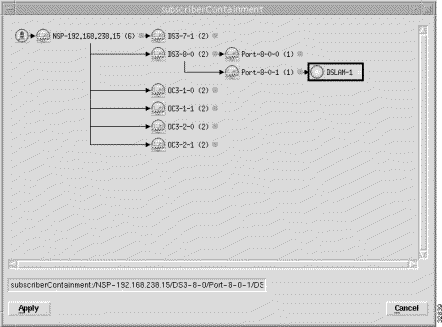
Step 9 Select a DSLAM to deploy the subscriber onto. The DSLAM objects were deployed earlier in this work flow. DSLAM-1 is selected in the example shown in Figure 6-62.
Step 10 Select Apply. The Containment Details window reappears.
Step 11 Select Forward.
The Object Details window appears.
Step 12 Enter the Subscriber QoS name.
Step 13 Select Finish to commit the deployment and create the Subscriber.
Step 14 Select Dismiss to close the Deployment Summary window.
You may wish to create more than one subscriber QoS. It is possible that a subscriber will subscribe to multiple services and may require or may be prepared to pay for different subscriber QoS. For example, the subscriber may have a bridge service that is uses for work purposes and is paid for by their employer. This service is probably quite high-value. The subscriber may also have their own personal Internet link that would probably be a lower grade service. So this type of subscriber would need multiple subscriber QoS objects created.
To create a new subscriber QoS, proceed as follows:
Step 1 Select the Deploy, Cisco 6400 UAC, Subscriber QoS option from a Line Card.
The Deployment wizard launches.
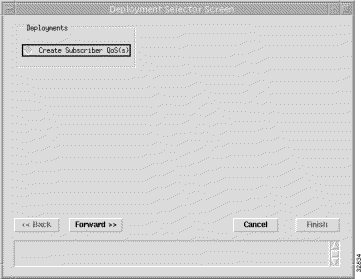
Step 2 Select the Create Subscriber QoS(s) option from the list of deployments (if not already selected).
Step 3 Select Forward.
Step 4 Enter the Number of Subscriber QoSs to create. Enter "1" as an example.
Step 5 Select Forward.
The Object Details screen appears.
Step 6 Enter the Subscriber QoS Name in the Attributes frame.
Step 7 Select Forward.
Step 8 Click Select in the Containments frame. The subscriberContainment window appears.
Step 9 Select the Subscriber from the object map.
Step 10 Select Apply.
Step 11 Select Forward.
Step 12 Select Finish to commit the deployment and create the Subscriber QoS.
Step 13 Select Dismiss to close the Deployment Summary window.
The Subscriber QoS Configure window allows you to configure existing Subscriber QoS parameters.
Step 1 Select the Cisco 6400 UAC, Subscriber, Configure Subscriber QoS option at a Line Card.
The Subscriber QoS Configuration window appears.

Step 2 Select the appropriate NSP, DSLAM and Subscriber to display the QoS Parameters associated with the selected Subscriber.
Step 3 Configure the parameters in the QoS Parameters frame, as required, or alternatively apply a QoS profile. Refer to the "Applying a QoS Profile to a Subscriber QoS" section for further details.
Step 4 Select the Save option from the File menu to save the information.
Step 5 Select the Close option from the File menu to close the Subscriber QoS Configuration window.
Step 1 Start MapViewer and select the Chassis map.
Step 2 Select a Line Card.
Step 3 Select the Cisco 6400 UAC, Subscriber, Configure Subscriber QoS option.
Step 4 Select the Subscriber QoS and right click.
Step 5 Select Delete Objects.
Step 6 Check the details in the Deletion Summary window.
Step 7 Click Finish.
Step 8 Click Dismiss.
You can apply an existing QoS profile or configure the QoS Parameters individually.
To apply a QoS profile to a subscriber QoS, proceed as follows:
Step 1 Select the Cisco 6400 UAC, QoS, Configure Subscriber QoS option from a Line Card.
Step 2 Select the Apply Profile option from the Edit menu.
Step 3 Select the profile from the list of profiles displayed.
Step 4 The QoS Profile parameters are now copied into the QoS Parameters frame and saved automatically.
Step 5 Click Dismiss.
Subscriber Connection Management is the process of configuring the subscriber PVC incoming to the Cisco 6400 UAC, and connecting the subscriber to the required service.

Refer to the "Creating a Subscriber and Associated Subscriber QoS" section for further details.
Step 1 Start MapViewer and select the Chassis map.
Step 2 Select a Line Card.
Step 3 Select the Cisco 6400 UAC, Subscriber, Configure Subscribers option.
The Subscriber Configuration window appears.
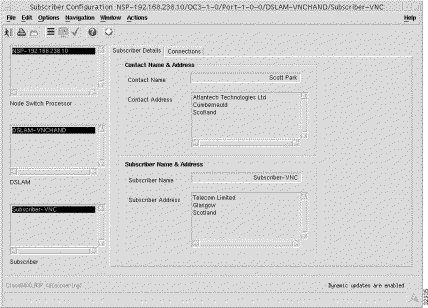
Step 4 Select the Subscriber Details tab (if not already selected).
Step 5 Select an NSP, DSLAM and Subscriber from the appropriate lists at the left-hand-side of the window.
Step 6 Enter a Contact Name and Contact Address into the Contact Name & Address frame for the selected subscriber, as required.
Step 7 Enter a Subscriber Name and Subscriber Address into the Subscriber Name & Address frame, as required.
Step 8 Select the Connections tab.

Step 9 Select Activate Polling or Deactivate Polling (as required) in the Bandwidth Utilization frame.
The Bandwidth Utilization frame enables you to switch on/off, on an individual subscriber PVC basis, bandwidth utilization monitoring. Activate utilization polling using the Activate Polling button (shown in Figure 6-67). The Receive/Transmit Utilization gauges indicate the utilized bandwidth as a percentage of the Peak Cell Rate specified for the connection. The 6400 UAC permits the subscriber to exceed their allocated bandwidth. The gauge shows 100% when a user exceeds their peak cell rate.
Step 10 Select the Save option from the File menu to save the subscriber information.
Step 11 Select the Close option from the File menu to close the Subscriber Configuration window.
Step 1 Start MapViewer and select the Chassis map.
Step 2 Select a Line Card.
Step 3 Select the Cisco 6400 UAC, Subscriber, Configure Subscribers option.
Step 4 Select the Subscriber and right click.
Step 5 Select Delete Objects.
Step 6 Check the Deletion Summary details.
Step 7 Select Finish.
Step 1 Select the Cisco 6400 UAC, Subscriber, Connect Subscribers option from an NSP card.
The Service/Subscriber Connection window (shown in Figure 6-68) appears.

The Service/Subscriber Connection window is divided into four tabbed sections, Connect, RFC1483 Routed, PTA-MD and RBE.
Step 2 Select the Subscriber and the Subscriber QoS.
Step 3 Select the ATM Port that the Service Instance resides on.
Step 4 Select a Service Instance.
Step 5 Select and the appropriate tab and enter relevant information when connecting to RFC1483 Routed, PTA-MD or RBE services. Refer to the "Service Configuration Windows" section for further details on the parameters contained in the RFC1483 Routed, PTA-MD and RBE tabs.
Step 6 Enter a Username and Password in the Authentication (PPP-IP only) frame.
Step 7 Select the Automatic VPI/VCI Allocation in the Internal PVC Parameters frame.
Step 8 Click Connect. A pop up window appears displaying the IOS transaction log as connection occurs.
If the Connect operation fails the service instance remains in the Decommissioned state (that is, no configuration will have been applied to the Cisco 6400 UAC). Failure diagnostics information can be located by examining the IOS log.
Common failure causes include:
Step 1 Select the Cisco 6400 UAC, Subscriber, Disconnect Subscribers option from an NSP card.
The Service/Subscriber Disconnection window appears.

Step 2 Select the Subscriber.
Step 3 Select the connection object that connects the Subscriber to the Premium Service Service Instance.
Step 4 Click Disconnect.
A pop up window appears to warn you that the selected subscriber is about to be disconnected.

Step 5 Click Yes to disconnect the subscriber. The Action Report window appears confirming that the subscriber has been disconnected.

Click Close to close the Action Report window or click Save to save the Action Report. The Action Report can be saved and used for diagnostic purposes. The " *** No errors encountered *** " message appears to show that disconnection was successful.
This may be used, if for example, you wish to alter the upstream data rate.
To edit a commissioned service, proceed as follows:
Step 1 Select Configure Services from an NRP
Step 2 Select the service instance you require.
Step 3 Decommission the service (beware, this will cause subscriber service interruption).
Step 4 Edit the service as required.
Step 5 Commission the service.
This operation can be performed without disconnecting the subscriber.
Step 1 Select the Configure Subscribers option from a line card.
Step 2 Select the NSP, DSLAM and Subscriber to display the subscribers details.
Step 3 Enter the contact and subscriber details and then save your changes.
Step 1 From a line card select disconnect subscribers.
Step 2 Select the subscriber to disconnected.
Step 3 Press the Disconnect button.
Step 4 Select a new service.
Step 5 Connect the subscriber to a new service instance (and NRP, if appropriate).
![]()
![]()
![]()
![]()
![]()
![]()
![]()
![]()
Posted: Wed Feb 2 13:17:17 PST 2000
Copyright 1989 - 2000©Cisco Systems Inc.